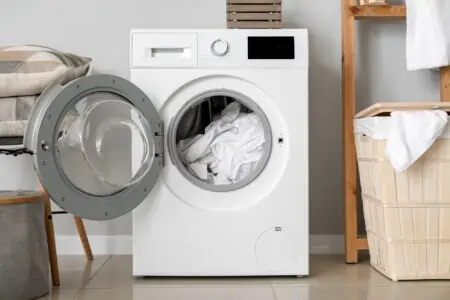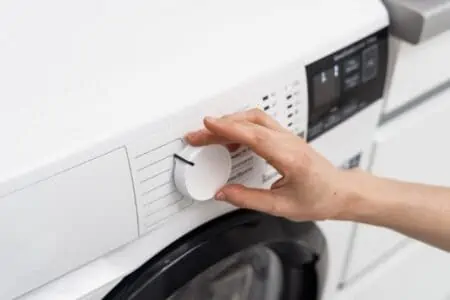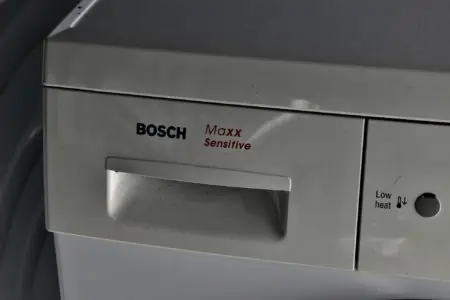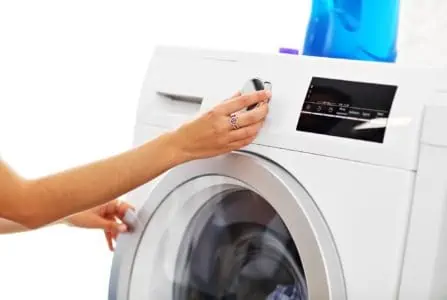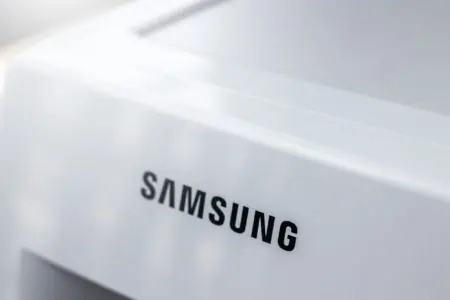When buying a new washing machine, you should consider several significant details. What features does it have? Is it energy efficient? What size washer do I need?
In this post, we’ll be answering the latter question to help you decide what size washing machine you need for your home and family.
We’ve put together a list of four important factors to help you decide. We also created a handy washing machine sizes chart. By the end, you’ll know the best capacity to go for.
Key Takeaways
- Choose the right washing machine size based on family size: small (3.2 cubic feet) for 1-2 people, medium (4.5 cubic feet) for 2-4 people, and large (5+ cubic feet) for 5 or more people.
- Consider factors like laundry frequency, budget, type of laundry load, and energy efficiency when selecting a washing machine.
- Washing machine sizes chart: small washers (3.2 cubic feet) for 1-2 people, medium washers (4.5 cubic feet) for 2-4 people, and large washers (5-6.2 cubic feet) for 5+ people.
- Dryer sizes should also be based on family size: small dryers for 1-2 people, medium dryers for 3-4 people, and large dryers for families of five or more.
What Size Washer Do I Need?
Let’s walk through what important factors you should consider to determine the ideal washer size for your family.
1. How Frequently You’ll Be Doing Laundry
This is probably the most important detail to consider to help you find the right size washing machine.
If you live on your own and don’t do laundry very often, then you can get away with a smaller machine.
But if you have a large family and a bottomless pile of laundry, a larger machine can help you get through the loads much quicker.
2. What’s Your Budget?
The larger the machine, the more expensive it will be. That’s simply because they are bigger, there are usually more features, and they are more efficient. If you’re on a budget, a small or medium washer might be right for you at this current moment.
3. Type of Laundry Load
If you live in a warmer place, then you’re most likely going to be washing smaller articles of clothing such as shorts, t-shirts, and swimwear. Therefore, you may be able to get away with a smaller machine.
If you live in a colder area, your clothes will be bulkier. You’ll be washing sweaters, jeans, outdoor wear, and knitted items. A larger appliance will be more suitable.
4. Energy-Efficient
Larger washing machines will use more water and electricity per cycle. If you aren’t going to be filling the machine up every time, then a smaller appliance will be more energy efficient.
However, if you’re going to fill the tub each cycle, it ends up being more energy-efficient per pound of laundry. That’s when we suggest opting for a larger machine.
So the bottom line is, choose a small appliance if you don’t have much laundry to do, if you live alone, if you’re on a budget and live in a warm area. Go for a larger appliance if you have a big family, the funds for the machine, larger items of clothing, and will be filling the washing machine with each load.
Washing Machine Sizes Chart
If you’re wondering, “What size washing machine do I need?” it can help to know the specs.
Below is a handy table to give you a quick idea of the various features of different size washing machines.
This includes the cubic feet capacity, what size family it’s best for, how many towels the washer can accommodate, and the average pounds of laundry per load.
| Washer Size | Capacity (cubic feet) | Number of Towels Washer Can Fit | Approximate Family Size | Pounds of Laundry Per Load |
|---|---|---|---|---|
| Small | 3.2 | Nine | 1-2 people | 12-14 |
| Medium | 4.5 | 11 | 2-4 people | 14-16 |
| Large | 5-6.2 | 17 | 5+ people | 20-25 |
Small Washers
A small washer is generally around 3.2 to 3.5 cubic feet. This smaller capacity is suitable for single people or couples.
You may find these washers are typically top-loading machines. You can also find portable options, which are great for small homes.
Although these machines are more compact, they can still accommodate up to 14 pounds of laundry — or around nine full-size towels — so you can stay on top of your chores.
Medium Washers
Medium washers come in a more standard size with a capacity of 4.5 cubic feet. They can wash 14 to 16 pounds of laundry per load, which is roughly the size of 11 full-size bath towels. This is a safe option for a family of four.
You’ll find medium washers in the top load and front load style, and in a variety of price points. Many different brands make medium washers, including Whirlpool, Samsung, Bosch, and more.
Large Washers
If you have more than five people in your home or are washing larger laundry loads regularly, then we recommend a large washer.
These appliances have a capacity of 5 to 6.2 cubic feet. This is capable of 20-25 pounds of laundry — or roughly 17 full-size bath towels!
While large washers are more expensive, they are practical for folks and families doing larger frequent loads. In fact, if you’re hoping to wash bedding, such as a king-size comforter, and don’t want to take it to a professional cleaner, a large washing machine is going to be helpful.
How to Calculate Capacity of a Washer
When determining what size washing machine do you need, it’s helpful to know the capacity in cubic feet. But what if the washing machine manufacturer doesn’t disclose this information? Well, we have a handy formula for you!
All you need to do is the machine’s radius in feet, the depth in feet, and pi (3.14).
- Measure: Use a measuring tape to record the washing machine’s specs.
- Find the radius: When measuring the radius, you can measure from the center of the tub to the edge. Another method is measuring the diameter from side to side, then dividing by two.
- Multiply the radius: Multiply the radius by the radius. For example, if the radius is 0.75 feet, your calculation will be 0.56.
- Multiply by pi: Multiply the above calculation by pi. For instance, 0.56 times 3.14 equals 1.76.
- Multiply by depth: Multiply the above calculation by the depth. For instance, if the depth is 2 feet, then your cubic feet volume is 3.53.
In summary, the formula is radius x radius x pi x depth. That equals the washer’s capacity in cubic feet.
What Size Dryer Do I Need?
Some appliances are a combined washer and dryer. They are practical but not as effective as buying a dryer separately.
If you’re in the market for a dryer as well, our advice is similar. Opt for a small dryer if there are 1-2 people, and you’re doing small irregular laundry loads.
Opt for a medium dryer for 3-4 people households and regular medium size loads of laundry. And opt for a large dryer if you’re a family of five or more, and do frequent large loads of laundry.
In general, tumble dryers vary from 15 pounds to 22 pounds.
- 15-16 pound dryers: Small families.
- 17-20 pound dryers: Medium families.
- 20-22 pound dryers: Large families.
What Size Washer Do I Need for a King Size Comforter?
It depends on the tog rating of your comforter. If it’s a lighter comforter, then you might be able to wash it in a small washing machine effectively.
For king-size winter comforters, we recommend a washing machine with a capacity of at least 4.5 cubic feet — a medium washer.
However, based on our experience, a large machine will be best for a more effective clean where the water and detergent can effectively mix and agitate the comforter clean.
So you can clean a king-size comforter in all size machines, but a large machine will handle it really well.
What Size Washing Machine Do I Need to Wash a Queen Size Quilt?
It depends on the weight of the quilt. If the quilt weighs 15 pounds, then a medium washer will do. But some queen-size quilts can be much heavier, and therefore, you may need a large washing machine.
Sizing Specialists
You asked what size washing machine do I need, and we answered! Now you know all the important specs for choosing your washer size.
To quickly recap, there are three basic sizes: small, medium, and large.
Choose a small washing machine for 1-2 people or an average of 12-14 pounds of laundry per load.
Medium washers are great for 2-4 people families and 14-16 pounds of laundry.
Large machines are best for families with five or more people and 20-25 pounds of laundry per load.






